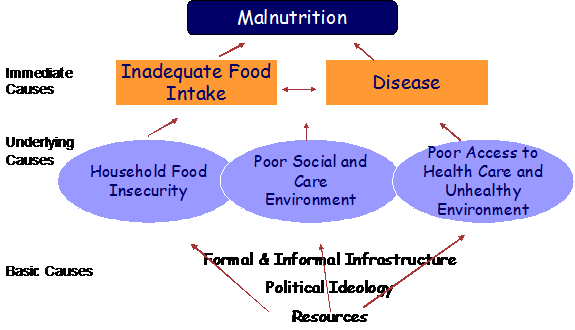Underlying causes
(go to Outline)
The third perspective is the underlying causes of malnutrition. The UNICEF framework gives three main categories of underlying causes, as shown in the following schema.

Household food insecurity, or the lack of food, is a major factor in many humanitarian emergencies. Displaced populations are often separated from their normal source of food. Although some agencies, such as the World Food Programme, have standardized methodologies specifically to assess food insecurity, there are no consensus recommendations regarding assessment methods. One simple way to crudely estimate the contribution of household food insecurity in a malnourished population is to compare the prevalence of acute protein-energy malnutrition in children less than 2 years of age to the prevalence in children 2-4 years of age. Older children normally have a lower prevalence rate of acute malnutrition, but if food insecurity is an important factor, they too will become significantly malnourished.
Poor social and care environment often consists largely of poor infant feeding practices, poor home care for ill children, and poor health care seeking behaviour. Nutrition surveys will often ask questions about breastfeeding, general feeding practices, and home care and clinic visits during the last episode of illness. However, this is not the only applicable method for assessing the contribution of this group of underlying causes.
Poor access to health care and unhealthy environment can often be assessed using disease surveillance data and program data. In nutrition assessments, surveillance data for those diseases which are known to have substantial and rapid impact on nutritional status, such as dysentery and pneumonia, should routinely be analyzed. Many such diseases can produce rapid weight loss even in children and adults with normal pre-disease nutritional status. The environment can be assessed with standard indicators of sanitation and water supply (for more information, see section on Water Supply, Sanitation, and Shelter).